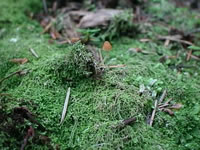The Tasks and Garden Chores for February
Even though it may still be cold, damp and miserable outdoors, an occasional dose of sunshine could certainly put the gardening bug into you. With a little luck, Mother Nature will send a few blossoms your way this month.
We are now at a time when we can no longer put off those garden projects, waiting for a nice day...... Don't be caught off guard though, winter is far from being over! If exceptionally cold weather is forecast, provide protection for early flowering or tender plants by covering them with some type of cloth material.
Remove the covering as soon as the weather moderates again.

Shrub and Tree Care
Deciduous shrubs and trees are still dormant enough to transplant this month. Once the buds have begun to swell, it will be to late. Azaleas and other small shrubs transplant easily but moving large Rhododendrons and other specimen size plants takes considerably more effort.
Trees that weren't fed last fall should be deep fed by punching a series of 1-2 inch holes two feet apart around the drip line and filled with an appropriate food. A mulch of well composted manure is also an excellent treat for your tree.
Mid to late February is the time to fertilize shrubs and evergreens. Use an acid type Rhododendron fertilizer to feed evergreens, conifers, broad leaf evergreens, Rhododendrons, Azaleas and Camellias. Use an all-purpose fertilizer to feed Roses and other deciduous trees and shrubs. If you use granular type fertilizers, be sure to water it in thoroughly.
Prune your summer flowering shrubs now but be aware that spring bloomers have already produced their buds last fall, and pruning them now will result in the loss of flowers. Forsythia, Quince, Spirea and other early spring flowering shrubs should be pruned a little later, after they have finished flowering.
Pruning should be done to improve the shape of the plant, as well as to open up the center of the plant to good air circulation and sun exposure. Always start your pruning by removing all dead, decayed or broken branches. The methods of pruning Roses vary, depending on the type of Rose. Climbing roses should be thinned out to get rid of last years tangled growth.
It's a good time to stroll around and trim back any branches that were damaged by the ravages of winter.
If you haven't yet applied your dormant spray to your fruit trees, DO IT NOW!!Annuals, Perennials and Bulbs in the Garden
Plants that may have been pushed out of the ground by frost heave should be pressed firmly back into place.
Plant Daylilies, Bleeding Hearts, and Hostas this month.
Deciduous vines such as Honeysuckle should be pruned for shape.
Most perennials can be divided and moved up until the time they begin to show new growth.
Check your over-wintered plants such as Fuchsias and Geraniums, and if they are shriveled water them lightly.
Stored summer flowering bulbs may try to start into growth if they are subjected to heat. They should be kept very dry, and stored at 45° F. If they are shriveling, put them into slightly damp peat moss, but keep them cool!
If you plan to grow Lobelia, Ageratum, Verbena, Petunia, Vinca, or other slow growing plants from scratch, the seeds should be started indoors in the later part of the month.
Fruit and Vegetable Gardening
Rhubarb, Horseradish, Asparagus and Artichokes can be planted this month.
Kiwis and Grapes must be pruned by Valentine's Day to prevent sap 'bleeding'.
Strawberries can be planted as soon as they become available.
Summer bearing Raspberries and Blackberries should have all the canes that produced fruit last year removed.
Remove any trunks from Currants that are over 3 years old.
The vegetable garden should get its first good tilling of the year, if weather and wetness permits, to allow the weather to aid you in breaking up the dirt clods. Exposed weeds and their seeds will hopefully also perish.
Odds and Ends in the Garden
Your House Plants may notice the longer days, and begin growing. You can begin feeding them again, but only use a half strength solution of your House Plant fertilizer until the growth is robust.
Continue feeding our feathered friends, you'll want them to stick around to help you in insect control when the weather warms again.
Did you check your garden tools yet? Don't wait 'til the spring rush to get your mower back in shape!
In the event of snow, be sure to shake or brush off the white stuff from the branches of your evergreens and shrubs.
It's time to turn the compost pile!
